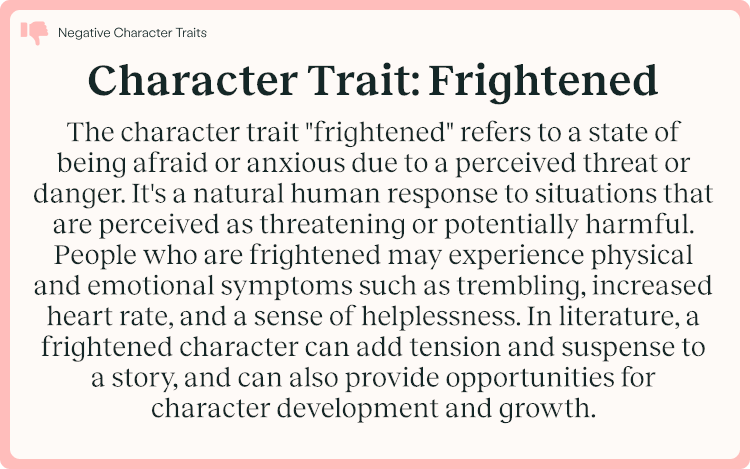
To engage your reader, it's important to always show not tell the traits of your characters. The character trait "frightened" refers to a state of being afraid or anxious due to a perceived threat or danger. It's a natural human response to situations that are perceived as threatening or potentially harmful. People who are frightened may experience physical and emotional symptoms such as trembling, increased heart rate, and a sense of helplessness. In literature, a frightened character can add tension and suspense to a story, and can also provide opportunities for character development and growth.
- Possible causes of being frightened
- Behaviors associated with being frightened
- Attitudes associated with being frightened
- Thoughts and struggles associated with being frightened
- Emotions associated with being frightened
- Facial expressions associated with being frightened
- Body language associated with being frightened
- Behaviors associated with being frightened
- Growth and evolution of frightened characters
- Stereotypes of frightened characters to avoid
- Negatives of being frightened
- Positives of being frightened
- Verbal expressions of frightened characters
- Relationships of frightened characters
- Examples from books of characters who are frightened
- Writing exercises for writing frightened characters
Possible causes of being frightened
You might want to weave these into your character's back story to build a more believable character.
- Exposure to violence or danger
- Negative life experiences
- Social pressure or bullying
- Anxiety or phobias
- Past trauma or abuse
- Genetics or temperament
- Cultural or religious beliefs
- Overprotective upbringing
- Lack of confidence or self-esteem
Behaviors associated with being frightened
You may be able to show your character's trait of frightened by using these.
- Difficulty breathing
- Running away or hiding
- Racing heartbeat
- Freezing or becoming immobile
- Sweating
- Clinging to someone or something
- Crying or whimpering
- Nausea or stomach discomfort
- Trembling or shaking
Attitudes associated with being frightened
You may be able to show frightened through their attitudes.
- Being on edge or tense
- Feeling a sense of impending danger or doom
- Feeling overwhelmed or helpless
- Being unable to think clearly or logically
- Avoiding situations or objects that trigger fear
- Experiencing a fight or flight response
- Being jumpy or easily startled
- Feeling anxious or nervous
- Having an increased heart rate or sweating
Thoughts and struggles associated with being frightened
Here are some ideas for things your frightened character may think or struggle with.
- Constantly feeling on edge and anxious
- Second-guessing themselves and their abilities
- Struggling to trust others or make meaningful connections due to a fear of vulnerability
- Battling with their own self-doubt and negative self-talk
- Trying to maintain a facade of strength or confidence to hide their fear from others
- Avoiding situations or people that they perceive as threatening
- Feeling powerless and out of control
- Difficulty making decisions or taking action due to fear of the consequences
- Experiencing physical symptoms such as shaking, sweating, or a racing heart
Emotions associated with being frightened
Here are some ideas for emotions your frightened character may experience.
- Apprehension
- Unease
- Nervousness
- Anxiety
- Panic
- Horror
- Fearfulness
- Dread
- Terror
- Paranoia
- Alarm
Facial expressions associated with being frightened
Here are some facial expressions your frightened character may exhibit.
- A furrowed brow
- Wide-open eyes
- Raised eyebrows
- A dropped or open mouth
- A pale or sweaty complexion
- Rapid breathing or gasping
- A tensed jaw or clenched teeth
- Quivering or trembling lips
- A backward or sideward head tilt
Body language associated with being frightened
Here is some body language your frightened character may exhibit.
- Sweating or clammy skin
- Hunching shoulders or making oneself smaller
- Stuttering or stammering speech
- Backing away or cowering
- Freezing in place or becoming paralyzed
- Clenched fists or tensed muscles
- Rapid breathing or gasping for air
- Trembling or shaking
- Wide eyes or dilated pupils
Behaviors associated with being frightened
Here are some behaviors your frightened character may exhibit.
- Running away or hiding
- Racing heartbeat
- Trembling or shaking
- Difficulty breathing
- Sweating
- Crying or whimpering
- Clinging to someone or something
- Freezing or becoming immobile
- Nausea or stomach discomfort
Growth and evolution of frightened characters
Here are some ways that your frightened character may grow and evolve over time.
- Develop empathy and compassion for others who are also afraid
- Develop courage and become more confident
- Discover inner strength and resilience
- Challenge their beliefs and perspectives
- Learn to trust themselves and others
- Learn to take risks and try new things
- Confront their fears and overcome them
- Learn to manage their fear and use it to their advantage
- Become more self-aware and understand their fears better
Stereotypes of frightened characters to avoid
Try to avoid writing stereotypical frightened character like these examples.
- The character being portrayed as weak or cowardly
- The character being overly emotional or hysterical
- The character being portrayed as a victim or helpless
- The character easily giving up or succumbing to pressure
- The character being too dependent on others for support and guidance
- The character being paralyzed by fear and unable to take action
- The character being constantly in need of rescuing by others
Negatives of being frightened
Here are some potential negatives of being frightened. Note: These are subjective and some might also be seen as positives depending on the context.
- Avoidance of situations or people that trigger fear, which can limit experiences and opportunities
- Difficulty concentrating or focusing on anything other than the source of fear
- Physical symptoms such as sweating, shaking, and increased heart rate
- Irrational behavior and reactions
- Paralysis and inability to act or make decisions
Positives of being frightened
Here are some potential positives of being frightened. Note: These are subjective and some might also be seen as negatives depending on the context.
- Improved reflexes and reaction time
- Ability to think quickly and creatively in response to danger
- Greater appreciation for safety and security
- Heightened awareness of surroundings
- Increased adrenaline and energy
Verbal expressions of frightened characters
Here are some potential expressions used by frightened characters.
- "My hands are shaking."
- "Please help me!"
- "I hear strange noises."
- "I'm scared!"
- "I can't handle this."
- "I'm too afraid to move."
- "My heart is pounding out of my chest."
- "I'm terrified!"
- "I feel like I'm being watched."
- "I'm paralyzed with fear."
- "I'm feeling very uneasy."
- "I'm shaking with fear."
- "I feel like I'm going to die."
- "I can't breathe."
Relationships of frightened characters
Here are some ways that being frightened could affect your character's relationships.
- They may avoid conflict at all costs, even if it means sacrificing their own needs and desires.
- Frightened people may cling to others for support and reassurance, seeking constant validation from them.
- They may experience physical symptoms such as shaking or sweating when faced with stressful situations, which can be misinterpreted by others as a lack of confidence or competence.
- They may become easily overwhelmed and struggle to manage stress and anxiety, which can impact their relationships with others.
- They may struggle with vulnerability, keeping their emotions guarded and hidden from others.
- They may become overly dependent on others for decision making, lacking confidence in their own abilities.
- They may struggle to trust others, constantly questioning their intentions and actions.
Examples from books of characters who are frightened
- Harry Potter (Harry Potter series by J.K. Rowling)
- Katniss Everdeen (The Hunger Games by Suzanne Collins)
- Lyra Belacqua (His Dark Materials by Philip Pullman)
- Bilbo Baggins (The Hobbit by J.R.R. Tolkien)
- Frodo Baggins (The Lord of the Rings by J.R.R. Tolkien)
- Scout Finch (To Kill a Mockingbird by Harper Lee)
- Holden Caulfield (The Catcher in the Rye by J.D. Salinger)
- Winston Smith (1984 by George Orwell)
- Elizabeth Bennet (Pride and Prejudice by Jane Austen)
Writing exercises for writing frightened characters
Here are some writing exercises you might try for learning to write frightened characters.
- Play around with different writing techniques to convey your character's fear. For example, you could use short, choppy sentences to create a sense of urgency or employ metaphor to describe their fear in a more abstract way.
- Think about how your character's fear might drive their actions and decisions. Do they avoid situations that scare them, or do they try to face their fears head-on?
- Consider the impact of your character's fear on their relationships with other characters. Do they push people away or cling to them for comfort?
- Write a scene where your character is faced with a situation that triggers their fear. Try to describe their physical and emotional reactions in detail.
- Start by creating a backstory for your character that explains why they are frightened. Perhaps they had a traumatic experience in their past, or they have a phobia that they cannot shake.
- Experiment with different ways to show your character's fear. For example, you could describe their racing heartbeat, sweaty palms, or the way their voice trembles when they speak.
